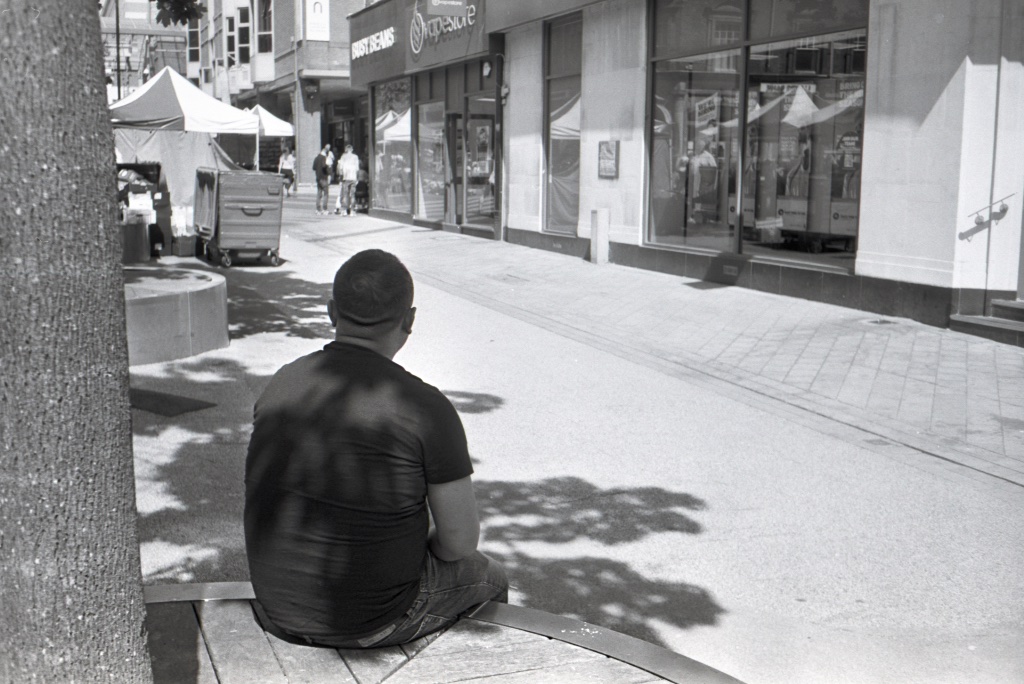
Konica Pop Review: Dating from 1982 the Konica Pop is a classic budget point and shoot. This one comes from 1985 or later as its shows the ‘Hexanon’ lens marking. The lens is stated as being a 36mm f4 and is of course fix focused.
The specification for the shutter was 125th but I timed this one at 90th of a second based on the results of my ZTS shutter tester. Most SLRs will have a deviance of about 20% but the Konica Pop would show a 28% deviance – possibly acceptable and of course there’s no way of knowing how age may have affected it. The lens on this one was minty fresh and showed no issues though.
The lens on these was a fixed aperture with a maximum aperture of f4 – I would guess its minimum at around f8 based on its film stops.
The only way to adjust aperture is by changing the film speed ISO/ASA setting which is limited to 100, 200 or 400 ASA. Each step in the ASA setting basically opens/closes the lens aperture by 1 stop.
The Konica Pop sold around 1.5 million units in a range of colours including pink, yellow, blue, white, green, red and of course black and while it was undoubtedly popular in its day its frankly a bit of a horror. Don’t be fooled by that Hexanon script on the lens we are talking toy camera territory here!

I found this one in a charity shop and typically someone had left its two AA batteries inside to melt down. Fixing it was a complete nightmare as the original owner or someone else had managed to bust the battery cover, probably while trying to get the batteries out. Repairing this was an exercise in drilling out some tiny holes to fit plastic lugs to hold the whole thing together and fixing this probably took longer than rebuilding a 35mm SLR.
On top of battery chamber woes the finish on these cant take Isoprop Alcohol. It bleaches the colour out of the plastic! This made getting the light seals out a complete perisher of a job. As if it couldn’t be made tougher Konica glued the light seals in with something akin to a contact or epoxy glue! This made removing them a horror job. Needless to say the seals in this one were shot to pieces.
The body slot seals were awkward but the biggest challenge was the door seals. The door has seals running all the way round it and I swear it used more light seal foam than any other camera I have fixed. Doubtless the huge quantities of foam were a fix to the overall shoddy construction of the camera. Overall assembly is best described as cheap and nasty.

The camera features a pop up flash (hence the ‘Pop’ name) and a press in switch to manage flash reduction if you are close to the subject. The viewfinder is like something from a Christmas cracker with a kind of faux ‘brightline’ frame to correct for any parallax errors but you do get a red warning light if the light levels are too low and of course a flash ready neon indicator. The low light LED is driven by a CdS cell on the front of the camera. The camera is wholly mechanical of course, the batteries are only there to drive the flash and activate the low low-light warning. So if you bagged one with a wrecked battery chamber you could still shoot with it in daylight conditions.


It’s as simple as camera as possible with almost no user input at all – just wind on and fire in most situations. What enterprising manufacturers before the age of auto-focus used to call focus free. Rewinding is accomplished by a fold out metal crank handle on the base of the camera. It also quixotically has a tripod mount which seems a bit superfluous with a fixed shutter speed and no self timer but the Konica boys probably thought they may as well do it just in case they got a bad review – frankly from this sample I cant see how they would ever have gotten a good one!

Thanks to a bit of an accident with the first roll of film (alright I opened the film door without rewinding for the first time ever in about 10,000 rolls of film and 50 years of photography), I had to rush back to the charity shop I was repairing this for and beg to borrow it again so I could quickly bash through a roll of FP4.
With some experience of the camera you could, with some practice shots control aperture through the ASA rating. Black and white film is tolerant of two stops so you could probably use the ASA to manage as a rough and ready aperture control. For the film I shot I had to work blind to any issues having no experience with the camera so shot everything at ASA 100 and told the lab to work to that film speed.
As a result the camera would have been operating at its widest aperture so it could perhaps be improved with faster film and the resulting smaller aperture. Anyway, here’s some pics shot with it. Sunlight was bright around midday and I had to work fast in a town centre to get a roll of 36 shot.



So there you go. You may conclude from my relentless banging on about it that it’s simply terrible and from a repair perspective it was. Even a simple job like the light seals took a serious chunk of time even for a wizened old pro like me. The output was pretty dreadful, worse than the Instamatic 33 I had as a pre-teen BUT on the whole its a fun ‘toy camera’ to shoot with and I have to say despite its cheapness and overall rather poor quality it had a kind of charm to work with. You have to remember these were sold to mums and dads to get family pictures at the beach so its focus range was probably optimised for aunts, uncles and little Timmy at quite close quarters.
The restore work for this was done for a local charity shop as these cameras seem popular with hipsters and I offered to get the camera fully running so they could perhaps make some money rather than it being sold as junk.
Oddly enough on my return to the shop to hand the camera back after the roll of FP4 I got chatting with a student of film and they decided to buy the Konica Pop from the shop despite me pointing out a nice Miranda I tested and did some restore work on to help the shop out. The student was kind of wedded to the hipster vibe and I think they may have called it right. As a simple, uncomplicated intro to film it may well work well for them. Certainly with a bit of experience the Konica Pop may well turn out some interesting shots. It has an immediacy to it that more sophisticated cameras can never really achieve.
So…Summing up the Konica Pop – Its cheap, its nasty but its carefree and kind of fun. If it gets someone inducted into the magic of film it’s serving a worthy purpose and of course it was £35 in the till for the Princess Alice Charity so it’s all good.
Further Reading

Mel is one of the driving forces behind High 5 Cameras and writes all our articles.
Starting serious photography back in 1972. Over the years she got to shoot film with most of the major brands in 35mm and large format as both a studio photographer and content provider for websites in the early life of the web. These days she is rediscovering photography and has become the GOTO person for knowledge on camera repair advice.



